Update August 2021: IoT Analytics published a more recent blog on: 20 million cellular IoT chips missing in 2021 due to global supply shortage as Qualcomm continues to lead the market.
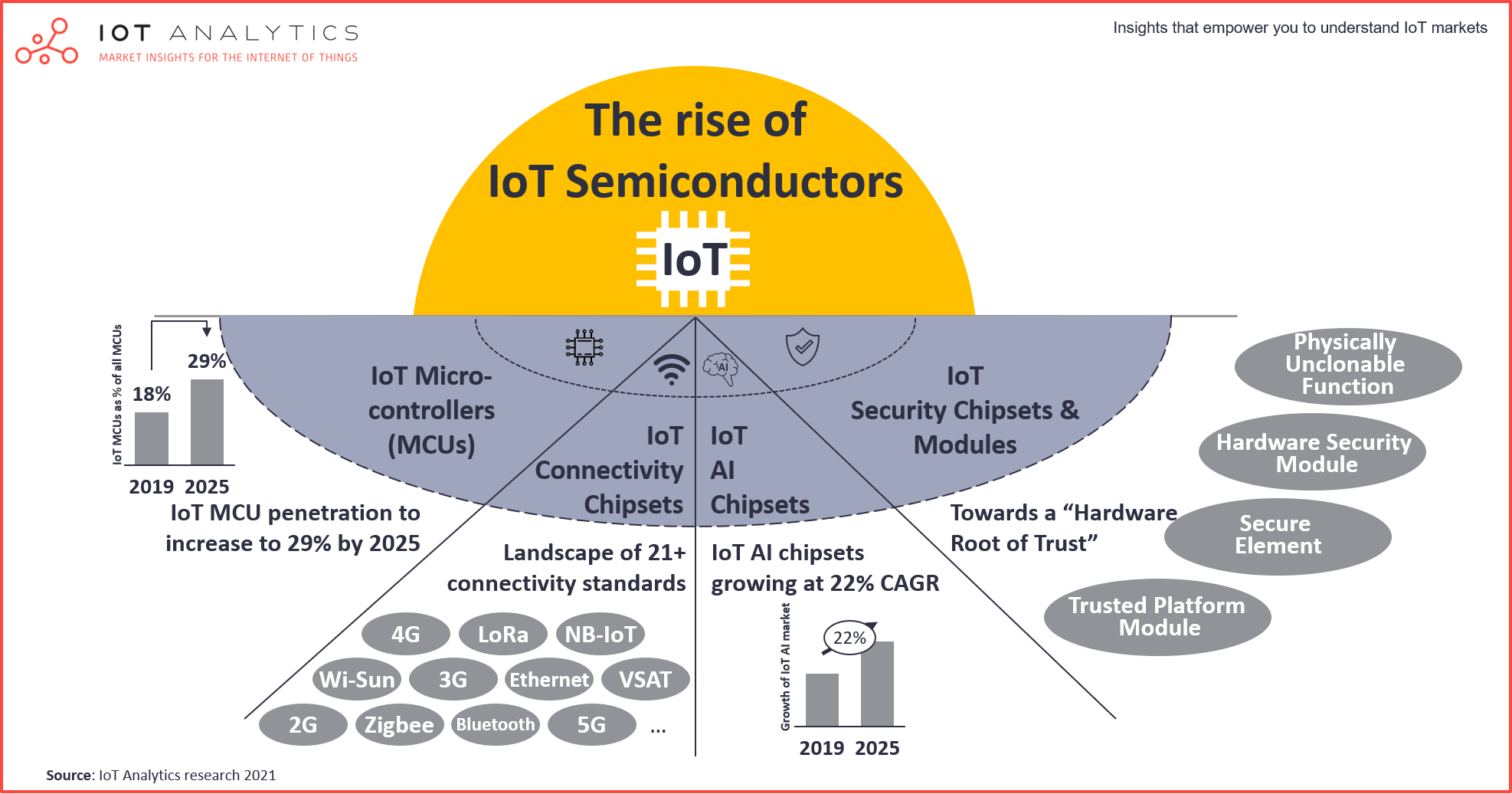
In short
- The penetration of semiconductor components classified as IoT is expected to grow from 7% in 2019 to 12% by 2025.
- Four key components are driving this IoT semiconductor growth: MCUs, connectivity chipsets, AI chipsets, and security chipsets and modules.
Why it matters?
- The increasing penetration of IoT semiconductors will necessitate chipmakers to put an enhanced focus on typical IoT requirements (e.g., ultra-low power, smaller form factor, built-in security)
- Device makers should see a flurry of new chips specifically designed explicitly with IoT in mind.
Semiconductors – a strongly outperforming technology sector
The Philadelphia Semiconductor Index, which tracks the value of the 30 largest semiconductor firms globally, increased by a factor of 5x in the last five years (from $80 in Jan 2016 to $416 in Jan 2021). The index not only handily beat the high-flying Nasdaq index (which increased by a factor of 2.8 in the same timeframe) but also other technology indices, such as cloud computing (e.g., the SKYY Index increased 3.5x in the same timeframe).
This staggering performance of value in semiconductor firms can be attributed to many factors. Most notably, the industry has profited from the need for more and higher-value semiconductor components for several newly emerging technologies. Key drivers include big data analytics, mobile communication, gaming, connected and semi-autonomous cars, and to a large degree, the fast growth of connected Internet of Things (IoT) devices.
According to our estimates, the number of active IoT device connections grew from 3.6 billion in 2015 to 11.7 billion in 2020. By the end of 2025, we forecast a total of 30 billion IoT connections. The rise of the IoT semiconductor market is broad and touches most industry segments, including industrial, automotive, energy and utilities, and healthcare. Consumer IoT devices such as smartwatches and smaller wireless accessories have seen a particularly high demand in recent years, which has prompted several companies that were not making IoT devices a few years ago to move into the IoT ecosystem (e.g., many of the smartphone makers).
The current IoT device explosion will continue to drive the IoT semiconductor market and will likely lead to further semiconductor innovations amid higher production volumes. IoT Analytics latest report on this topic forecasts the IoT semiconductor component market to grow at a CAGR of 19% from $33B in 2020 to $80B in 2025. In particular, four components will be in the spotlight: IoT microcontrollers (MCUs), IoT connectivity chipsets, IoT AI chipsets, and IoT security chipsets and modules.

Four key components driving IoT Semiconductors
IoT Analytics defines IoT semiconductors as those semiconductor components that either individually or collaboratively contribute to the functionality of an IoT device or other IoT equipment. As such, several semiconductor components qualify as IoT semiconductors.
Our research shows that the following four stand out in importance:
1. IoT Microcontrollers (MCUs)
In contrast to many other technology topics, IoT has a characteristically diverse set of use cases and applications. All of these applications demand different levels of performance and functionality. Often, MCUs (rather than MPUs) are a good fit to deliver the required flexibility (e.g., in terms of processing power) while at the same time presenting a very economical hardware choice for the application. An interesting trend is that IoT MCUs have now evolved from general-purpose MCUs and are sometimes
becoming IoT application-specific MCUs that cater to the exact requirements posed by a specific IoT application (e.g., In Q4 2020, NXP launched its S32K3 Automotive IoT MCU Series)
On the back of these trends, IoT Analytics expects the penetration of IoT MCUs in the general MCU market to grow from 18% in 2019 to 29% by 2025. Particularly 32-bit MCUs, which can be found in devices such as the well-known Raspberry Pi represent a sweet spot for IoT applications.
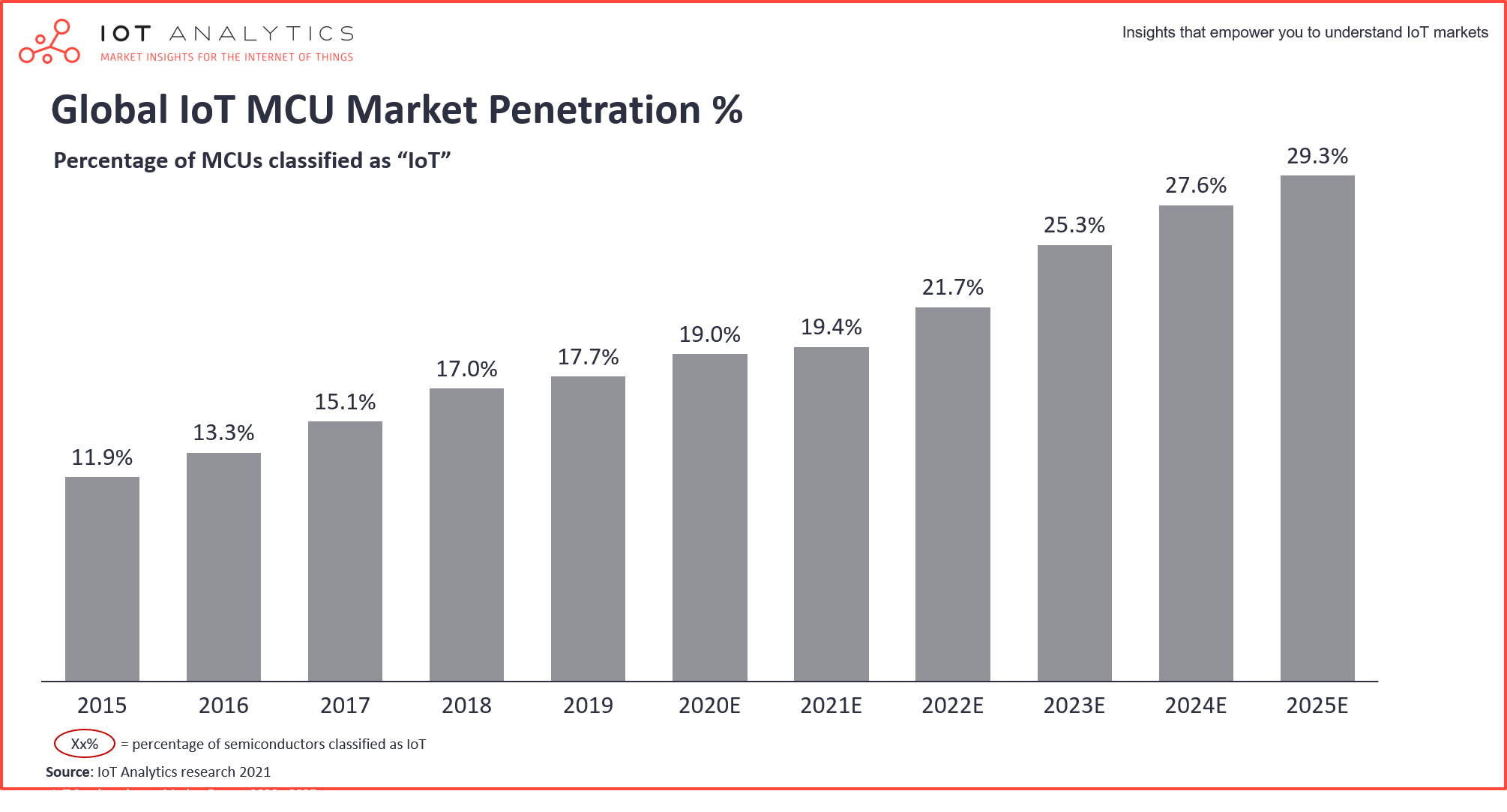
2. IoT connectivity chipsets
IoT connectivity chipsets are at the heart of all IoT connected devices and represent the largest IoT semiconductor market segment (35% of all IoT semiconductors in 2020). In recent years, the lack of globally accepted IoT connectivity standards and the varying requirements from different use cases and applications have led to a wide variety of connectivity options.
IoT Analytics identifies 21 main IoT connectivity standards (from a semiconductor point of view), including , among others, cellular IoT such as 3G or 4G, WLAN such as Wi-Fi, and wired connectivity.
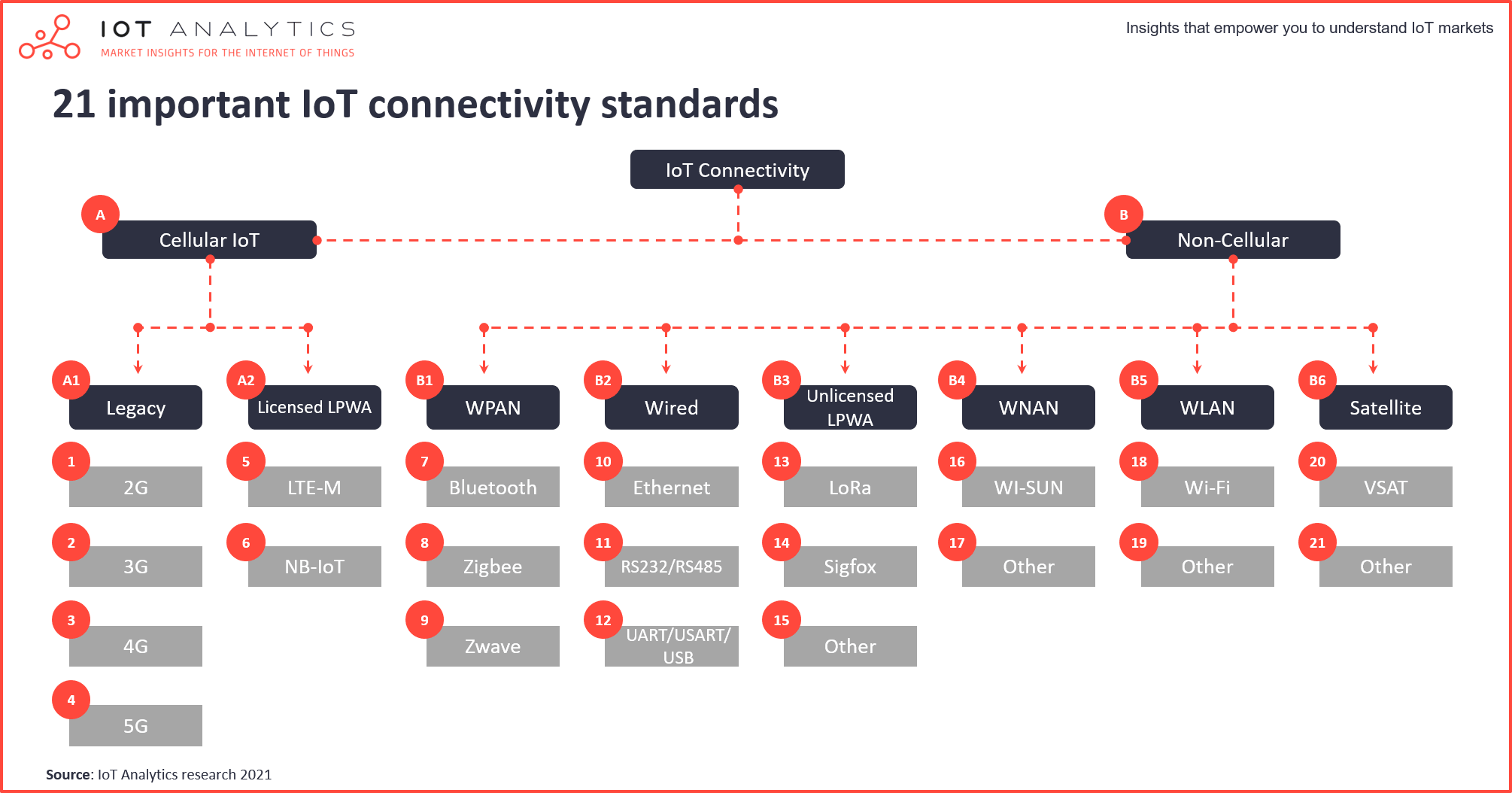
Cellular IoT. Cellular IoT chipsets currently play a large role in the market growth of IoT connectivity chipsets. IoT Analytics expects the global cellular IoT chipset market to grow at a CAGR of 37.5% between 2020-2025, driven by 5G (used for low-latency and high bandwidth IoT applications) and LPWA (used for low-power, low-bandwidth, low-cost IoT applications). Both the licensed/cellular LPWA market and the unlicensed LPWA market drive the market with LoRa based chipset and NB-IoT based chipsets set to continue to dominate this market segment.
WLAN. WLAN chipsets are driven by the new Wi-Fi 6 and Wi-Fi 6E standards that create high growth opportunities in the IoT Wi-Fi chipset market. With almost four times higher throughput capacity than Wi-Fi 5, the upgrade to Wi-Fi 6 opens the door for IoT applications with higher bandwidth requirements, such as Augmented Reality headsets.
Bluetooth. The IoT Bluetooth chipset market is currently driven by audio & entertainment and smart home-based devices. The relatively new Bluetooth 5 chipset market focuses mainly on IoT applications. It enables emerging applications with beacons and location-based services (e.g., for asset tracking) and provides greater flexibility in targeting multiple applications and use cases.
3. IoT AI chipsets
Many applications look for more complex data analyses and for these data analyses to be performed in real-time. In recent years, this has created an increasing demand for embedded AI chips at the IoT edge. IoT Analytics expects the global IoT AI Chipset to grow at a CAGR of 22% between 2019-2025. This growth is driven by parallel computing offered by three different types of chipsets: GPUs, ASICs & FPGAs. FPGA-based AI chipsets are of particular importance for the cloud as well as in the 5G era. The chips help reduce latency, improve memory access, and make communications between devices much more power-efficient. Traditionally, data centers have used FPGAs as sidecar accelerators to a CPU.
Recently, however, companies such as Xilinx or Microsoft have started using FPGAs in the data path where high-speed ethernet connects directly to the FPGA instead of the CPU.
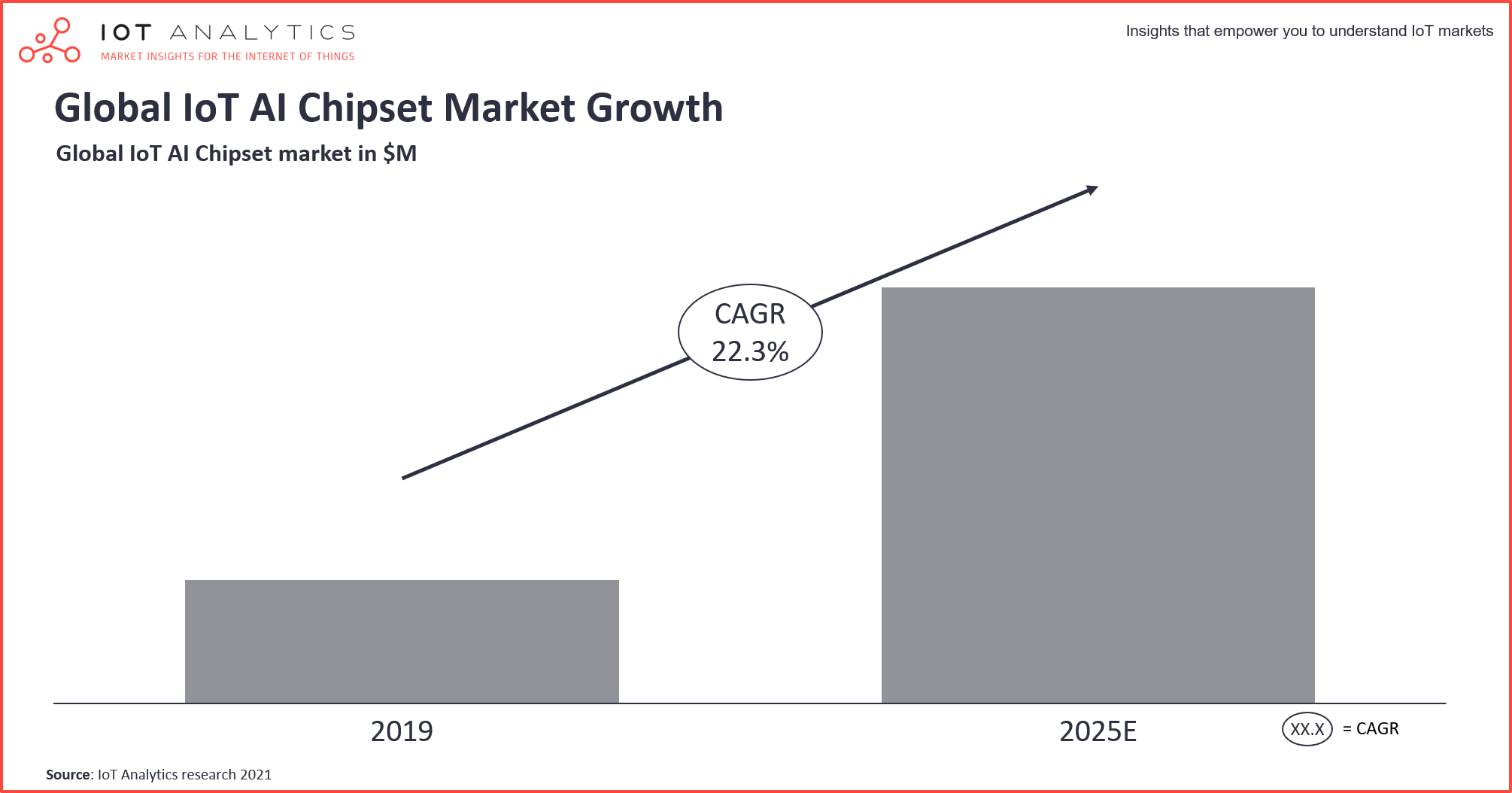
4. IoT Security chipsets and modules
According to Nokia’s Threat Intelligence Report 2020, IoT devices now make up 32.7% of the infected devices observed. The share of IoT infections increased by 100% in 2020. The rise in threats for IoT devices requires constant adaptation of security solutions. In many cases, traditional software security is seen as insufficient for the overall security architecture. Thus, there is a unique need to secure hardware alongside the data flow from edge devices to the cloud.
Although companies generally have various options where they implement embedded hardware security, implementing it at the MCU/SoC level is proving as most advisable as it allows the data to securely flow through the internal bus. This can be done by embedding Secure Elements (SE) and Physical Unclonable Functions (PUF) to the system within the devices.
Another important security feature is “key injection” in the secure enclave/PUF and cryptographic key management to ensure the devices’ secure identity and the creation of a secure tunnel of data flowing within the device and from the device to the cloud. This integration enables a “hardware root of trust” with asymmetric encryption. It also creates a secure tunnel for the safe flow of data from chip to cloud, ensuring data security at rest and in transit.
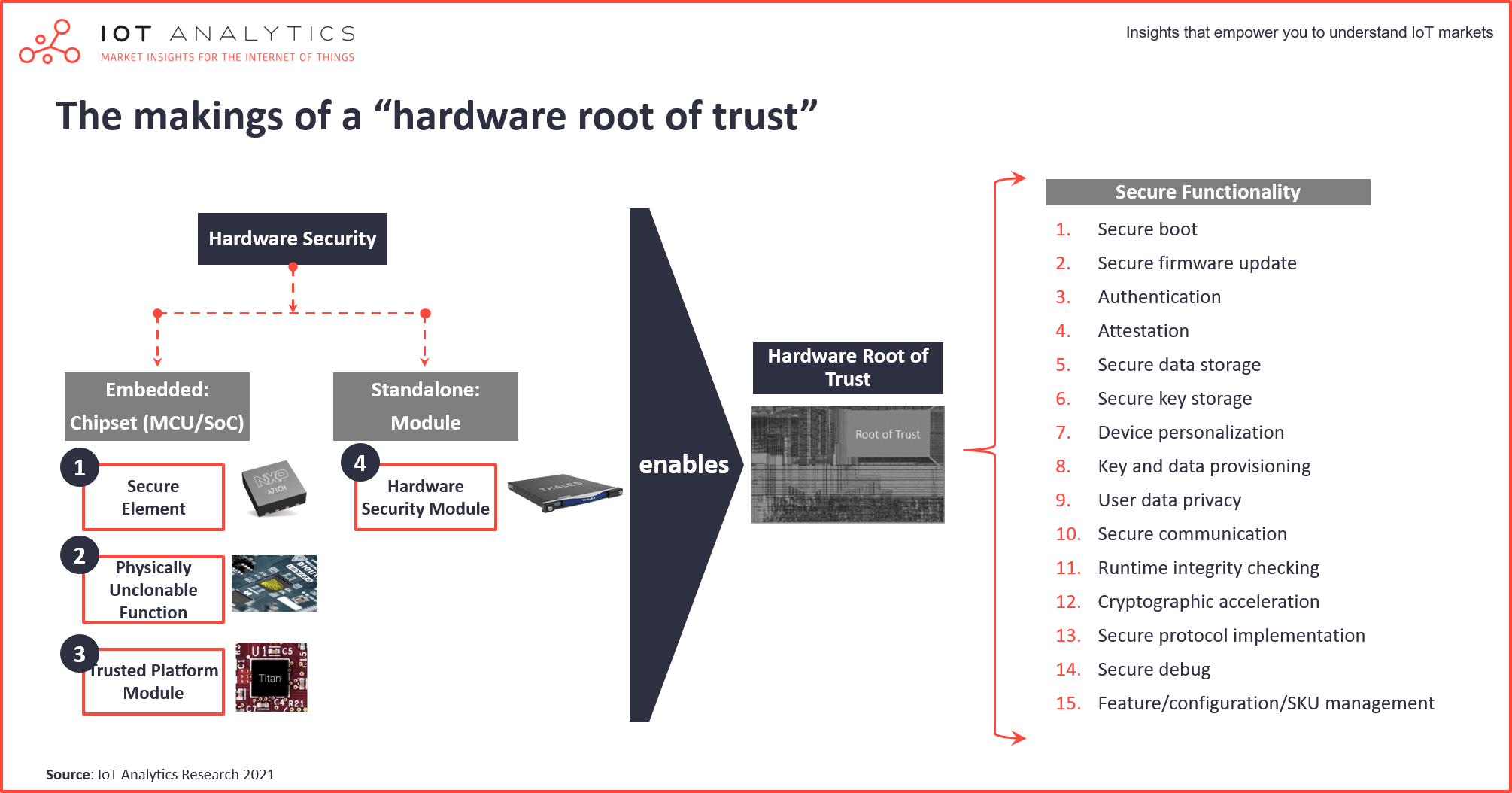
Outlook:
The market for IoT semiconductors is still in its infancy. With the penetration of semiconductor components classified as “IoT” expected to grow from 7% in 2019 to 12% by 2025, topics such as IoT MCUs, IoT connectivity chips, IoT AI chipsets, and IoT security chipsets will see growing importance in the coming years. It is hard to imagine that the semiconductor index can increase its value by another 5x in the next five years. But it is certain that IoT, more than ever, will be a driving force for these semiconductor companies and can provide significant new business.
More information and further reading
Are you interested in learning more about IoT semiconductors?
The “IoT Semiconductor Market Report 2020-2025” is a comprehensive 170-page report assessing the IoT semiconductor space. It provides a holistic view of the topic and includes a number of technology deep-dives in the IoT Semiconductor space. It also includes detailed market sizing & outlook by region, technology, and market segment until 2025 and a comprehensive summary of recent market developments, including 19 detailed insights uncovered by the IoT Analytics analyst team during 2020. This report is part of IoT ‘Analytics’ ongoing coverage of IoT Connectivity & Hardware (IoT Connectivity Research Workstream).
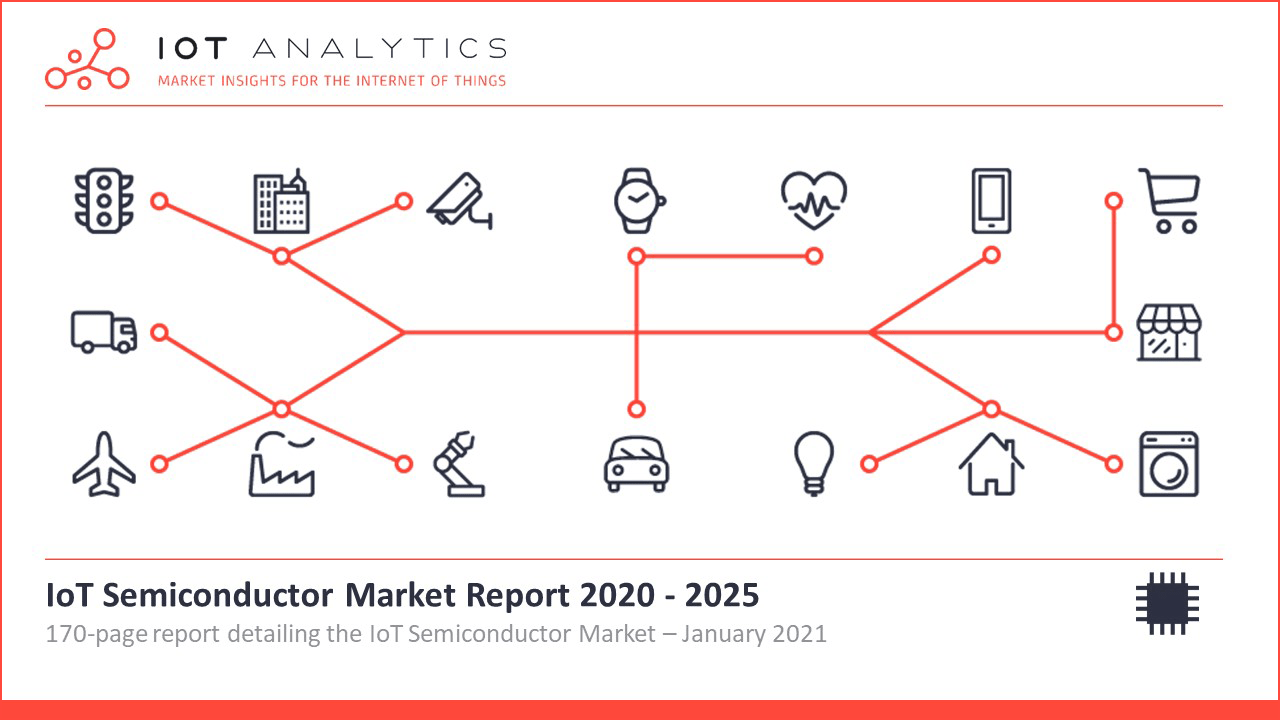
This report provides answers to the following questions (among others):
- What are key IoT Semiconductor components?
- What is the segmentation of the market, and who are the leading players?
- What is the current state of key market segments (EDA, IP, Foundry, MCU, Cellular Chipset, Wi-Fi Chipset, Bluetooth chipset, and AI chipset)?
- What are keys trends in the market?
- How big is the market today and how fast is it growing?
- Which region is leading the market growth?
- Which companies are leading and their market shares?
- And more…
Sample:
The sample of the report provides a holistic overview of the available analyses (outline, key slides). The sample also provides additional context on the topic and describes the methodology of the research. You can download the sample here:
Related articles:
You may also be interested in the following recent article:
Are you interested in continued IoT coverage and updates?
Subscribe to our newsletter and follow us on LinkedIn and Twitter to stay up-to-date on the latest trends shaping the IoT markets. For complete enterprise IoT coverage with access to all of IoT Analytics’ paid content & reports including dedicated analyst time check out Enterprise subscription.

